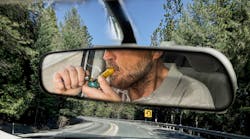Editor’s note: This the third part of a three-part series on legal marijuana’s emerging effects on trucking and transportation. Read part one and part two.
With legal marijuana more available than any time in history, how does the trucking industry deter drivers from partaking? Some fleets are finding that the threat of intense screening can be enough to keep the right drivers clean.
The states that legalized recreational weed had the largest increase in positive tests, according to an American Transportation Research Institute (ATRI) study published earlier this year. Since that study, Illinois has joined the other 10 and the District of Columbia where marijuana is legal without a prescription.
More than 1-in-5 of every American uses marijuana, according to a Yahoo News/Marist Poll in 2017. That would be about 55 million people. Of that group, more than half (63%) use cannabis regularly. More than a quarter of Americans now live in a jurisdiction that permits recreational marijuana. So more and more fleets are looking for ways to deter their drivers and other safety-sensitive employees from joining the millions of other Americans who are taking advantage of the liberalizing of cannabis laws.
Dr. Todd Simo, chief medical officer for HireRight, an employee background screening service said there are three main ways to test for drugs: urine, saliva and hair. He said that the fourth way, a blood test, has been banned in some states.
J.B. Hunt started using hair-testing in 2006, which led to a drastic decline in positive drug tests of its drivers. That included a 93% reduction in positive tests after accidents; and a 63% reduction in positive random tests over the past 10 years, compared to the five years before 2006.
ATRI’s Research Advisory Committee documented the most promising methods to identify and deter marijuana-impaired driving. In 2017, 2.6% of commercial driver drug tests were marijuana-positive — a 4% year-over-year increase from 2016, according to ATRI. Pot also came up more in drug tests of federally-mandated, safety-sensitive occupations in 2017 compared to 2016: from 0.78% to 0.84%.
Drivers testing positive for cannabis who were killed in crashes in the U.S. doubled between 2007 and 2015, According to data from the National Highway Traffic Safety Administration. But those tests did not show if the driver was intoxicated at the moment of the crash — just that the driver had used cannabis recently.
“It is extremely concerning to motor carriers and our drivers that recreational marijuana is legal in so many states, yet as the ATRI report documents, a valid and widely accepted Breathalyzer-type test is not available to law enforcement,” said Mike Card, president of Combined Transport Inc. “ATRI’s study clearly defines a role for federal and state leaders to support law enforcement and others in keeping the roadways safe from those who choose to drive high.”
Ways to test
“Hair is an outstanding specimen to catch stimulate use and opioids,” Simo said. “Marijuana, to catch it in hair, you have to be a chronic daily smoker. You’re waking-and-baking” or at least using cannabis regularly.
“Urine, unfortunately, has a detection window — when using the federally recognized cutoffs — of only about seven days — not the 30 days that everybody talks about,” Simo said. “But still it’s seven days, which means you can smoke on Friday and be positive on Wednesday.”
There is emerging science to test for marijuana with oral fluid, which would show if a person was currently intoxicated by cannabis, which has a shorter intoxicated period than its impairment period.
“If you look at oral fluid, its detection window is less than 24 hours,” Simo said. “With an impairment window greater than 24 hours. Therefore, a lot of people in the warehouse and distribution space have moved to oral fluid for those warehouse workers. Why? Because if they’re positive, we’re making a derogatory employment action based upon impairment not based upon the positive test.”
RCU Labs has developed an oral test for detecting recent marijuana use. The company says its test, the RCU Test, can determine the presence of “five key cannabinoids” if they were smoked in the previous three hours or eaten within the previous eight hours.
Just this month, the analytical method behind the RCU Test was accepted by for publication by the Journal of AOAC International, a provider of consensus standards for food safety, food integrity and public health.
Using testing to find safer drivers
Greer Woodruff, J.B. Hunt’s senior vice president of safety, said the company knew it would shrink its driver pool when it switched to the more stringent hair-testing, which can detect drug use within the past 90 days. “But those were the drivers we didn’t want behind the wheel of one of our trucks,” he said last week during a discussion at the American Trucking Associations’ Management Conference & Exhibition in San Diego. “And it has served as a deterrent.”
“We felt that it complements our safety culture, it communicates that we are not going to permit illegal drug use,” Woodruff added, noting that hair-testing’s highest detected drugs are cocaine and opioids. “Those are not social issues to be discussed right now whether those should be permitted or not. And hair-testing can be effective at determining those.”
After years of decreasing positive random urine tests at J.B. Hunt, Woodruff said there has been a recent uptick in the past couple of years. So the company started implementing random hair-tests this year. Six drivers who were randomly tested came back positive for methamphetamines, four for cocaine, two for marijuana, two for opioids, and one for ecstasy.
“So we have added to our drug testing protocols to further deter people from feeling like that’s OK,” Woodruff said. “We’ve had to do a lot of education with the CBD oils. We’ve had to do a lot of education with people having to understand that even though a state may permit (marijuana use), it’s not permissible under federal regulations.”
“I think what Greer is doing here with a deterrent-based program is outstanding,” Simo said. “I applaud J.B. Hunt for putting safety first.”
“Because I like statistics — my whole life is statistics so I’ll give you this statistic: 10 out of 10 people doing drugs know it,” Simo said. “So if you’re all of a sudden using an illicit drug, they know it. And if you have a program to promote from your recruiting on up that says we’re about safety, we’re about deterring, all of a sudden you’re going to get a better candidate pool, a better set of drivers, and it will help your company be more profitable.”
What about CBDs?
The exception to that statistic might be CBDs, a component of medical marijuana that is derived directly from the hemp plant, which is a cousin of the marijuana plant. CBDs have been growing in popularity lately as a natural way to combat pain and other ailments. But because of federal law, they are unregulated, may claim to not have THC but that isn’t always the case.
“There are actually people suing CBD manufacturers that had too much THC in their product that could trigger off a positive test,” Paul Enos, CEO of the Nevada Trucking Association, said.
Enos is co-chairman of ATA’s newly formed Controlled Substances, Health & Wellness Working Group, which is tasked with tackling marijuana’s effect on trucking.
“So that’s out there. My recommendation to you, when you talk to your drivers about CBD: buyer beware. Watch out because if you test positive and it’s only because of CBD, it doesn’t medically account for it.”
“This is not as simple as you would think it would be,” said Harold Sumerford Jr., CEO of J&M Tank Lines and the other co-chairman of the ATA’s new substance and health working group. “There are a lot of complications within this topic.”
Woodruff encourages fleets to reevaluate their drug and alcohol policies. “Seek some legal advice from a law firm that has expertise in employment law practices because it is complicated in some cases across states. And even in specific cities. So you need to need to be well abreast of what can I do and cannot do in certain states in regards to certain kinds of testings. So I would encourage that.”
“I think this working group has done some really good work,” Woodruff said. “And as an industry, I think we have acknowledged that we have a safety crisis. If 10% of our industry are using illegal drugs and driving a truck, that is a problem. And it’s tarnishing the reputation of the majority of drivers that are hard-working men and women that are drug-free. And we shouldn’t let that 10% harm our companies, harm the image of our industry, harm the motoring public, who we’re expected to share the roads with. And tarnish reputations of hard-working men and women. And I think we have to take this on and vigorously try to move them out of the industry until they’ve been rehabilitated.”
Editor’s note: This the third part of a three-part series on legal marijuana’s emerging effects on trucking and transportation. Read part one and part two.




